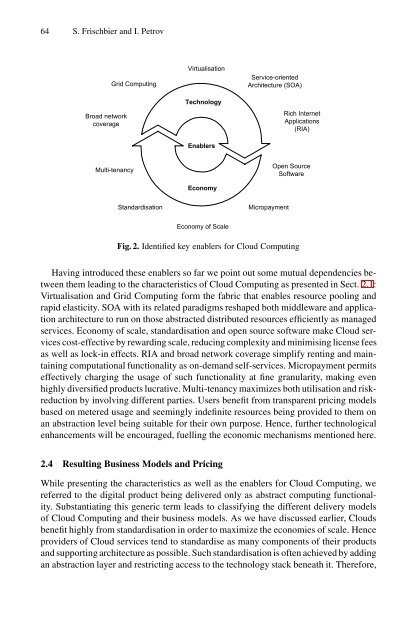Aspects of Data-Intensive Cloud Computing - DVS - Technische ...
Aspects of Data-Intensive Cloud Computing - DVS - Technische ...
Aspects of Data-Intensive Cloud Computing - DVS - Technische ...
You also want an ePaper? Increase the reach of your titles
YUMPU automatically turns print PDFs into web optimized ePapers that Google loves.
64 S. Frischbier and I. Petrov<br />
Broad network<br />
coverage<br />
Grid <strong>Computing</strong><br />
Virtualisation<br />
Technology<br />
Enablers<br />
Service-oriented<br />
Architecture (SOA)<br />
Rich Internet<br />
Applications<br />
(RIA)<br />
Multi-tenancy<br />
Economy<br />
Open Source<br />
S<strong>of</strong>tware<br />
Standardisation<br />
Micropayment<br />
Economy <strong>of</strong> Scale<br />
Fig. 2. Identified key enablers for <strong>Cloud</strong> <strong>Computing</strong><br />
Having introduced these enablers so far we point out some mutual dependencies between<br />
them leading to the characteristics <strong>of</strong> <strong>Cloud</strong> <strong>Computing</strong> as presented in Sect. 2.1:<br />
Virtualisation and Grid <strong>Computing</strong> form the fabric that enables resource pooling and<br />
rapid elasticity. SOA with its related paradigms reshaped both middleware and application<br />
architecture to run on those abstracted distributed resources efficiently as managed<br />
services. Economy <strong>of</strong> scale, standardisation and open source s<strong>of</strong>tware make <strong>Cloud</strong> services<br />
cost-effective by rewarding scale, reducing complexity and minimising license fees<br />
as well as lock-in effects. RIA and broad network coverage simplify renting and maintaining<br />
computational functionality as on-demand self-services. Micropayment permits<br />
effectively charging the usage <strong>of</strong> such functionality at fine granularity, making even<br />
highly diversified products lucrative. Multi-tenancy maximizes both utilisation and riskreduction<br />
by involving different parties. Users benefit from transparent pricing models<br />
based on metered usage and seemingly indefinite resources being provided to them on<br />
an abstraction level being suitable for their own purpose. Hence, further technological<br />
enhancements will be encouraged, fuelling the economic mechanisms mentioned here.<br />
2.4 Resulting Business Models and Pricing<br />
While presenting the characteristics as well as the enablers for <strong>Cloud</strong> <strong>Computing</strong>, we<br />
referred to the digital product being delivered only as abstract computing functionality.<br />
Substantiating this generic term leads to classifying the different delivery models<br />
<strong>of</strong> <strong>Cloud</strong> <strong>Computing</strong> and their business models. As we have discussed earlier, <strong>Cloud</strong>s<br />
benefit highly from standardisation in order to maximize the economies <strong>of</strong> scale. Hence<br />
providers <strong>of</strong> <strong>Cloud</strong> services tend to standardise as many components <strong>of</strong> their products<br />
and supporting architecture as possible. Such standardisation is <strong>of</strong>ten achieved by adding<br />
an abstraction layer and restricting access to the technology stack beneath it. Therefore,















